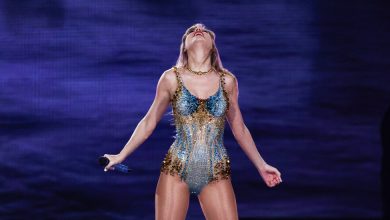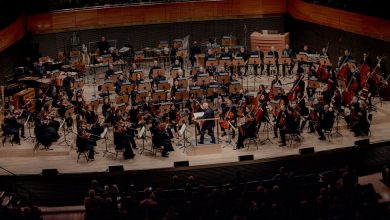Review: ‘The Book of Boba Fett’ Gives a ‘Star Wars’ Icon His Own Chapter

The enduring popularity of Boba Fett, a bit player in the “Star Wars” cosmos, makes perfect sense. He was introduced in “The Empire Strikes Back” not as a character but as a piece of pure, ingenious product design.
The inscrutable helmet with its dagger-like visor, the superheroic costume, the jet packs, the upright spaceship scooting through the ether: He was a jolt of style among the cheap plastic and laughable rubber that clothed most of the figures onscreen. He looked fantastic, but he also looked real, and he was the closest visual analogue to the Flash Gordon serials that inspired the films. In a movie series that became a merchiverse, whose process feels less like telling stories than like putting products on shelves, Boba Fett was a natural commodity.
Four decades later, he was put to use in establishing the Disney+ streaming service. The popular series “The Mandalorian” was built around the Fett iconography; its protagonist’s refusal to remove his helmet means that his character is embodied in his armor, in the indomitability and defensiveness it represents.
Fett himself turned up in the second season of “The Mandalorian,” his first live-action role since appearing as a child in “Attack of the Clones” in 2002. And now, finally, he’s a star, headlining his own seven-episode series, “The Book of Boba Fett,” which premiered Wednesday on Disney+. It’s from largely the same team, led by Jon Favreau, that produced “The Mandalorian,” and early in the first episode it acknowledges the centrality of costume and production design as the onetime bounty hunter Fett (Temuera Morrison) and his sidekick, Fennec Shand (Ming-Na Wen), ritually don their outfits like fashion models preparing for the runway.
To its credit, “Book” doesn’t dwell on that kind of fan service, though at this point in the evolution of “Star Wars” just about everything is a self-reference, like the mere presence of the diminutive desert-dwelling Jawas, or the arid landscapes of the show’s setting, the Skywalker home planet, Tatooine. The presence of Morrison is its own in-joke: Boba is a clone of another bounty hunter, Jango Fett, who was played by Morrison in “Attack of the Clones.”
In its first episode — no advance screeners were available — the story moves on several time tracks. In the present, Fett and Shand try to consolidate their control of the criminal element in Jabba the Hutt’s old stamping ground. When he sleeps, Fett has anxious flashbacks that fill in his history after what seemed to be his gruesome end in “Return of the Jedi.” (If the depiction of his escape from the digestive tract of the Sarlacc doesn’t agree with something you’ve seen in a “Star Wars” video game or comic book, repeat after me: “Noncanonical.”)
In the hands of Favreau, Dave Filoni and the director Robert Rodriguez, the premiere episode is “Mandalorian”-lite — competently put together, with the same quiet atmosphere and deliberate pace but without some of the earlier show’s moody stylishness or attention to detail. (And without, so far, anything that echoes the visual panache and merchandising genius of little Grogu, though of course the baby Yoda may cross over to “The Book of Boba Fett” at some point.) In Fett’s battles with human and animal foes, the dynamics of the action feel illogical, as if they haven’t been fully thought through.
A larger issue, though, may by Morrison and Wen, whose performances would be fine in a more routine, action-oriented show but are lacking the nuance they need for the more contemplative effect “Book” is trying for. (Matt Berry, David Pasquesi and Jennifer Beals are effective in smaller roles.) Favreau and company neglect the lesson from “Star Wars” history that they applied in their earlier show: A Mandalorian is more interesting with his helmet on.




